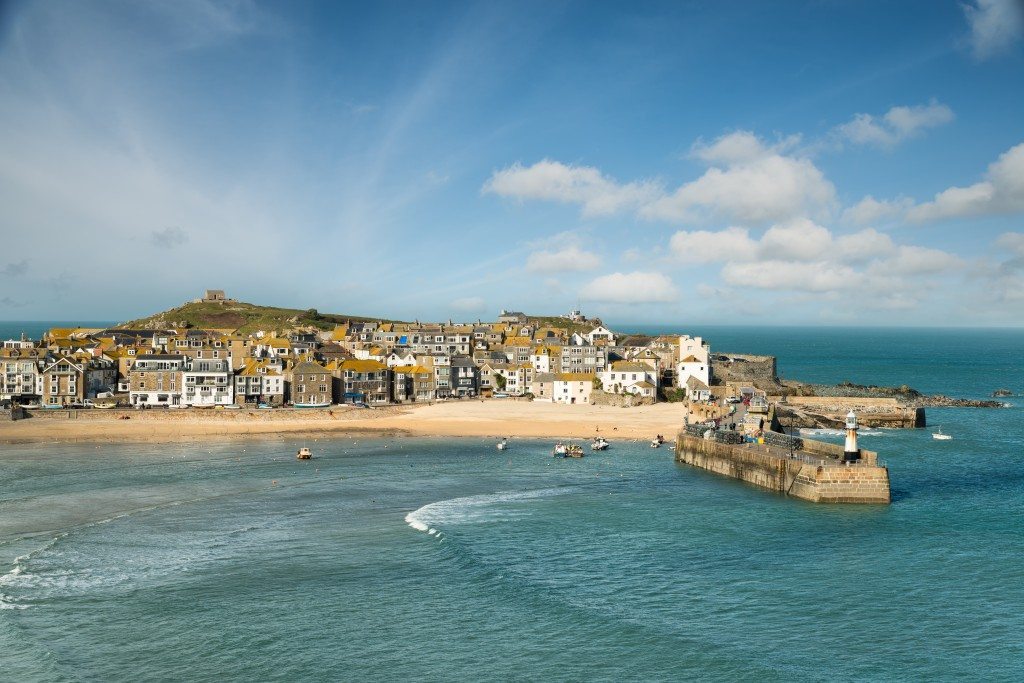
Just half a mile to the east of Carbis Bay, tucked away from the arty hub of St Ives, awaits the quiet, rugged beauty of Hawkes Point. Here you can pad barefoot along Porthkidney Sands, catch perfect little waves and climb the miners’ steps etched into the cliffs.
When you’re staying in and around Carbis Bay, it’s only natural to be lured towards the tourist hotspot of St Ives. However, head in the opposite direction – towards the headland at the eastern end of Carbis Bay – and within 10 minutes you’ll be greeted by the wilder, more tranquil beauty of Hawke’s Point and Porthkidney Sands.
From the South West Coast Path the view over Porthkidney Sands and a necklace of beaches stretching towards Godrevy Lighthouse, is one that many artists have captured on canvas. One of the most popular artists of the area is John Miller, whose paintings of this scenery have become famous worldwide.
It’s thought that Hawke’s Point may have got its name from a Mr Hawke, a smallholder who lived here and used to collect flotsam and jetsam from the beach. You can still climb down the old miners’ steps he used at the southern end of the beach, that were carved in the 19th century when a small copper and tin mine was in operation here.
The steep cliff stairway isn’t the only way to access the mile-long beach: slide down marram-topped dunes from the coast path, follow a short track from St Uny Church in Lelant, or – on very low tides – simply pad around the foot of the cliffs from Carbis Bay. Dubbed ‘Happy Dog Beach’ by the locals, the crowd-free Porthkidney Sands is indeed where hounds can frolic year-round – unlike on many of St Ives’ busier beaches where dogs are banned during peak season.
It’s not just walkers and their four-legged friends that enjoy the lack of crowds; surfers come here as well, to catch perfect little peelers that form in the shelter of the cliffs. If you don’t fancy hitting the waves, you’ll no doubt be tempted to dip your toes in the emerald sea, look for unusual for shells or even collect driftwood after a winter storm. Originally called ‘Porth Kinnis’, meaning ‘firewood beach’, its name suggests that Porthkidney was historically a haunt of wreckers long before Mr Hawke’s days, and it’s still a good spot for combing the shoreline to this day.
Once you reach the banks of Hayle estuary the beach peters out and the calmer waters attract an abundance of birdlife. Follow the footpath up to St Uny Church (past the oldest links course in the UK), and you can carry on along the coast path that skirts the estuary, or pick up the St Michael’s Way – an ancient Pilgrimage route to Mount’s Bay. However, if you’d prefer to get back to the art, food and culture of St Ives, it’s only a 3.5-mile walk back along the South West Coast Path. Or you can take the easy route on the coastal railway from Lelant Saltings, soaking up the views that inspired John Miller’s artwork from your window seat.
Carbis Bay Holidays’ Sea Urchin Apartments boast immense views of Porthkidney Sands and are footsteps from the South West Coast Path at Hawkes Point. There are also wide selection of beautiful dog friendly holiday cottages in St Ives.